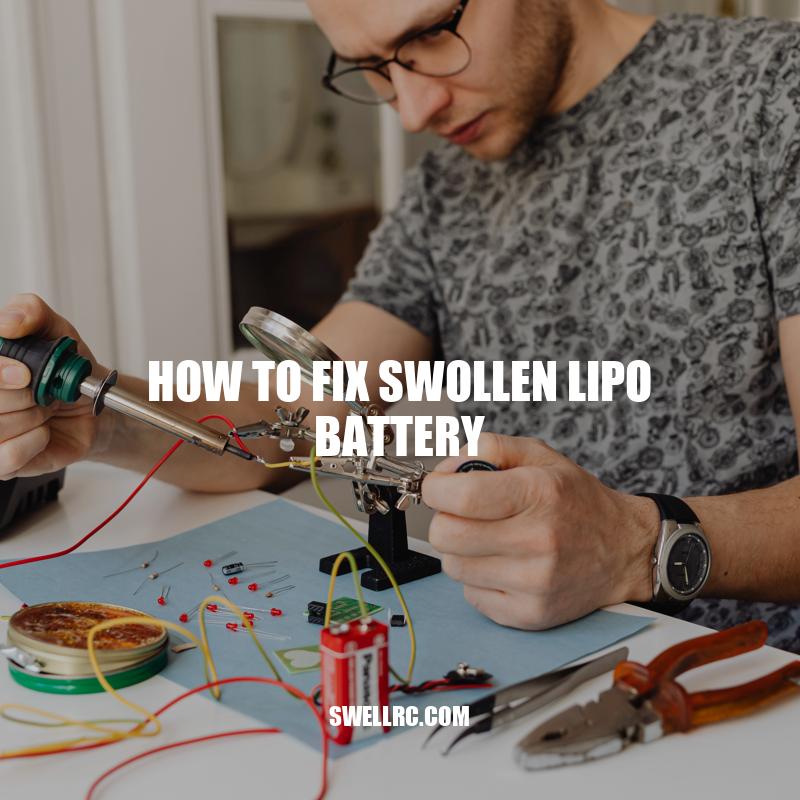Fix Swollen Lipo Battery – A Beginner’s Guide
Lipo batteries, or lithium polymer batteries, have become increasingly popular due to their high energy density, low weight, and versatility. They power a wide range of devices, such as drones, RC cars, and smartphones. However, they also pose some risks, especially if they swell or bulge. A swollen lipo battery indicates that one or more cells inside the battery has expanded and produced gas. This can happen for various reasons, such as overcharging, overheating, physical damage, or low-quality manufacturing. If left untreated, a swollen lipo battery can leak, catch fire, or explode, causing damage to property and endangering people’s lives. Therefore, it’s crucial to learn how to fix a swollen lipo battery and take the necessary precautions. In this article, we’ll guide you through the steps to repair a swollen lipo battery safely and effectively. We’ll also explain the causes and symptoms of a swollen lipo battery, the tools and materials you need, and some tips to prevent it from happening again. However, please note that repairing a swollen lipo battery requires some technical skills and knowledge, and if you feel unsure or uncomfortable, it’s best to seek professional help.
Why Do Lipo Batteries Swell?
There are several reasons why lipo batteries can swell, such as:
- Overcharging: If you charge your lipo battery too much, either by using the wrong charger or leaving it plugged in for too long, the cells can become overcharged and generate gas. Check the recommended voltage and current for your lipo battery, and use a balance charger that can prevent overcharging.
- Overheating: If you expose your lipo battery to high temperatures, either by using it intensely or storing it in a hot place, the cells can degrade and produce gas. Avoid using your lipo battery when it’s hot, and let it cool down before charging or storing it. Use a fireproof bag or container to store and transport your lipo battery.
- Physical Damage: If you drop, bend, puncture or crush your lipo battery, the cells can rupture and release gas. Inspect your lipo battery regularly for any signs of damage, such as dents, cracks or scratches, and replace it if needed.
- Poor Quality: If you buy a lipo battery from a non-reputable brand or source, the cells may be of low quality or mismatched, leading to uneven charging or discharging and eventually swelling. Choose a lipo battery from a trusted site like Amazon or a local hobby store, and read reviews and ratings from other users.
By understanding the causes of a swollen lipo battery, you can prevent it from happening or detect it earlier. In the next paragraph, we’ll explain the symptoms of a swollen lipo battery and what you should do if you notice them.
How do you stop a LiPo battery from swelling?
If you want to prevent your LiPo battery from swelling, follow these tips:
- Do not overcharge or over-discharge your battery.
- Avoid exposing your battery to extreme temperatures.
- Store your battery in a cool, dry place with a storage voltage between 3.7V and 3.85V per cell.
- Use a charging bag or container while charging and storing your battery.
In addition to these tips, make sure to always follow the manufacturer’s instructions and recommendations for your specific battery model. If you need to replace your LiPo battery, consider purchasing from reputable retailers like Amazon or HobbyKing that offer quality products and excellent customer service.
What Tools or Materials Do You Need to Fix a Swollen Lipo Battery?
Before attempting to fix a swollen lipo battery, you should gather the following tools or materials:
- Fireproof container
- Gloves
- Safety goggles
- Multimeter
- Charger
- Balance board
- Soldering iron
- Replacement cell (if needed)
- Soldering flux
- Soldering lead-free
- Heat shrink tubing
- Battery wrap
- Kapton tape
- Isopropyl alcohol
Keep in mind the following factors when handling these tools or materials:
- Safety: Wear protective gear, work in a well-ventilated area, and avoid exposing the lipo battery to heat, sparks, or water.
- Precision: Use the right size, type, and amount of each tool or material, and follow the correct sequence of steps.
- Care: Handle the lipo battery gently, and avoid bending, puncturing, or shorting any part of it.
By having the right tools and materials and using them properly, you can increase your chances of fixing a swollen lipo battery without further damage or risk. In the next paragraph, we’ll explain the basic steps you should follow to fix a swollen lipo battery.
What to do if LiPo battery swells?
If you notice that your Lithium-Polymer (LiPo) battery is swollen or puffed up, it is important to take immediate action as this can be a serious safety hazard. Here are the steps you should follow:
- Stop using the battery immediately and disconnect it from all devices.
- Place the battery in a fireproof container and store it outdoors or in a well-ventilated area away from flammable materials.
- Do not try to puncture, crush, or dispose of the battery in the trash. Instead, take it to a hazardous waste facility or contact your local recycling center for proper disposal.
- If you are unsure about how to safely dispose of a swollen battery, contact the manufacturer or a professional battery disposal expert for guidance.
It is important to remember that swollen batteries can be the result of overcharging, physical damage, or other factors, so it is crucial to properly store and charge your batteries according to manufacturer instructions to prevent any further incidents. For more information on battery safety and maintenance, visit websites such as Battery University or read reviews on products like the BATTMAN Dual Lipo Battery Voltage Checker.
What Are the Basic Steps to Fix a Swollen Lipo Battery?
Fixing a swollen lipo battery requires some technical skills and patience, but it can save you money and prevent accidents. Here are the basic steps you should follow:
Step 1: Discharge the Battery
You should discharge the battery to a safe level, such as 3.0-3.3 volts per cell, using a discharger, a low-voltage cutoff, or a resistor. Never discharge a swollen lipo battery below 2.5 volts per cell, as it can cause irreversible damage or fire.
Step 2: Separate the Damaged Cell
You should carefully cut or unsolder the tabs or leads that connect the damaged cell to the rest of the battery. Use a sharp and sturdy tool or a low-heat iron to avoid damaging the cell or causing a short circuit.
Step 3: Desolder the Leads
You should desolder the leads that connect the damaged cell to the balance board or the main board. Use a flux pen or a solder wick to remove the old solder, and clean the area with a brush or a cloth.
Step 4: Solder the New Cell
You should solder the new cell that matches the original brand, model, and capacity. Use a spot welder, a soldering iron, or a hot air gun to secure the tabs or leads to the new cell, and wrap the cell with a heat shrink tube or a battery wrap. Make sure that the polarity and the position are correct.
Step 5: Balance the Voltage
You should balance the voltage of the new cell with the remaining cells by using a balance board, a charger, or a multimeter. Check the voltage of each cell before and after balancing, and adjust the settings accordingly.
Step 6: Test the Battery
You should test the battery’s voltage, capacity, and internal resistance after fixing it to make sure it works well and safely. Use a charger, a discharge tester, or a wattmeter to measure these parameters, and repeat the test periodically.
If you are not confident in fixing a swollen lipo battery, you can ask for help from a professional or a forum. You can also check some online tutorials or videos that demonstrate the steps and the tips for fixing a swollen lipo battery.
How do you fix a swollen battery at home?
Unfortunately, swollen batteries are not fixable at home. They can be a danger to handle and should be disposed of properly. Do not attempt to puncture, open, or repair a swollen battery as it may leak toxic chemicals or explode. It is recommended to take the battery to a certified technician or dispose of it in accordance with local regulations.
If you are looking for safe and reliable batteries, there are a number of reputable battery suppliers online. Check out websites such as Amazon, Battery Mart, and Battery Warehouse for a wide selection of batteries and related accessories.
How Can You Prevent a Swollen Lipo Battery?
Preventing a swollen lipo battery is easier and safer than fixing one. Here are some tips you can follow:
Tip 1: Use a Quality Charger
You should use a charger that is designed for your lipo battery’s chemistry, voltage, and capacity, and that has safety features such as overcurrent protection, overvoltage protection, and automatic shutoff. Avoid using cheap chargers or chargers that have been modified or damaged.
Tip 2: Monitor the Charge Level
You should monitor the charge level of your lipo battery using a smart charger, a voltage checker, or a low-voltage alarm. Do not overcharge or undercharge your battery, as it can affect the performance and the lifespan of the battery. Follow the manufacturer’s instructions or the common rules of thumb for charging.
Tip 3: Avoid Extreme Temperatures
You should avoid exposing your lipo battery to extreme temperatures, such as high heat, direct sunlight, or freezing cold. Keep your battery in a cool and dry place, and do not store or transport it near flammable or conductive materials. Let your battery cool down or warm up before using or charging it.
Tip 4: Store the Battery Properly
You should store your lipo battery properly, such as in a fireproof bag, a metal box, or a lipo safe bag, and away from children or pets. Do not store your battery fully charged or completely discharged, and check the voltage and the condition of the battery periodically. Dispose of your battery safely and responsibly if it is no longer usable or has been damaged beyond repair.
Tip 5: Check the Battery Before Use
You should check the voltage, the balance, and the looks of your lipo battery before using it, and inspect it for any signs of damage or swelling. Do not use a swollen or damaged battery, and dispose of it properly as it can pose a risk to your safety and your equipment.
If you follow these tips, you are less likely to experience a swollen lipo battery and more likely to enjoy a longer and safer use of your lipo batteries. You can also consult some forums, blogs, or websites that provide more information and advice on how to prevent or fix a swollen lipo battery.
Is it safe to use a swollen LiPo battery?
It is not safe to use a swollen LiPo battery. Here are some reasons why:
- A swollen battery has experienced damage to its internal structure, which can cause it to leak, catch fire or explode.
- The swelling is caused by the build-up of gas inside the battery, which can lead to a sudden rupture.
- Continuing to use a swollen battery can result in serious injury, property damage, or even death.
If you have a swollen LiPo battery, the best course of action is to dispose of it immediately and properly. Do not attempt to puncture or disassemble the battery yourself. Check with the manufacturer of the battery, or search for a certified recycling facility that can dispose of the battery safely.
Conclusion
In conclusion, fixing a swollen lipo battery may seem daunting at first, but with the right tools, knowledge, and precautions, anyone can do it. It is important to know why lipo batteries swell, how to detect the signs of a swollen battery, and how to fix it safely and effectively. Moreover, it is equally important to prevent a swollen lipo battery by using a quality charger, monitoring the charge level, avoiding extreme temperatures, storing the battery properly, and checking the battery before use. By following these guidelines, you can improve your lipo battery’s performance, longevity, and safety, and save yourself from potential accidents or damages.
If you have any questions, feedback, or suggestions, please feel free to leave a comment or contact me directly. I am always happy to help and learn from your experiences. You can also check some other articles or videos on lipo batteries and RC hobbies, such as the websites of RC Groups, Lipo Battery Guide, and Flite Test. Remember to be safe, responsible, and innovative, and have fun flying or driving!



